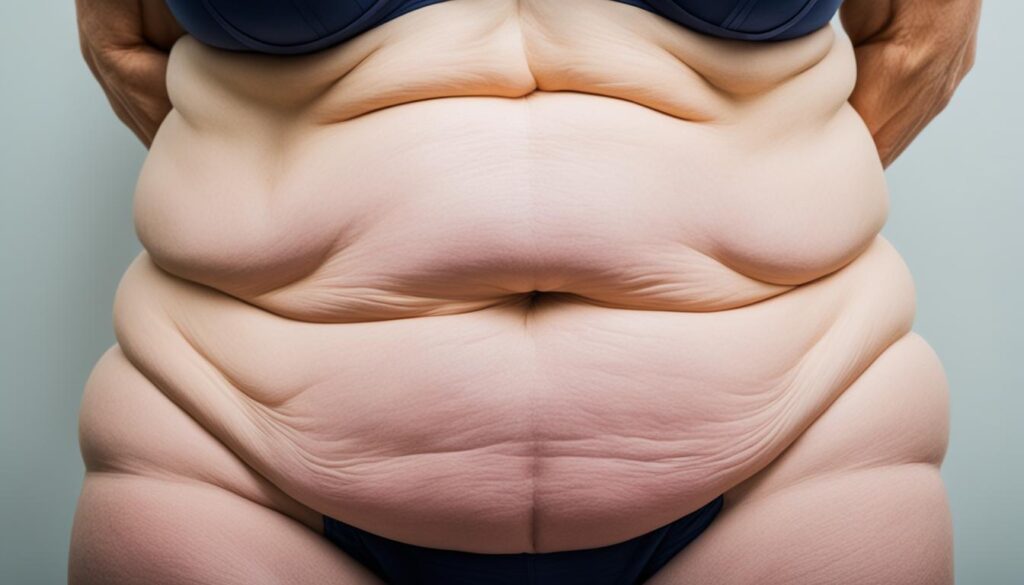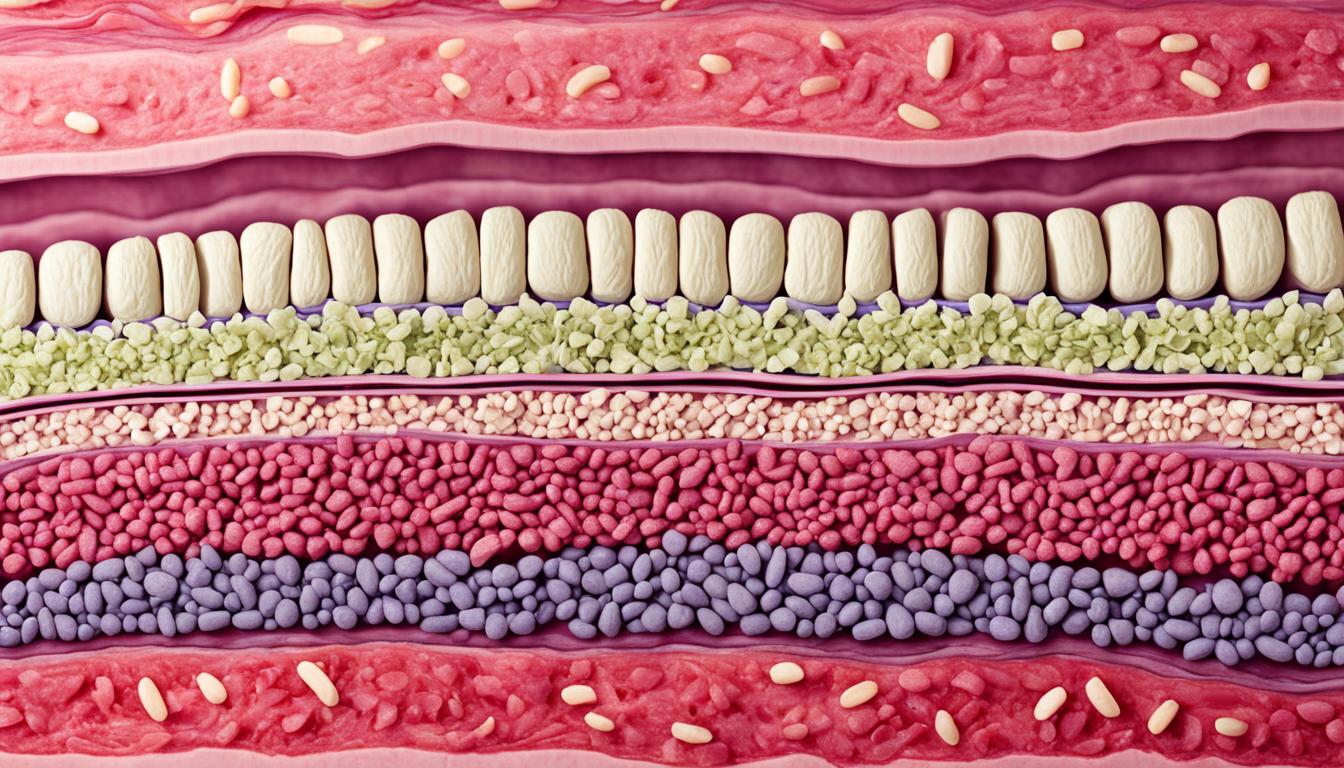Which Belly Fat Is Hardest to Lose?
Belly fat, particularly in the lower abdomen, is known to be the most stubborn and difficult to eliminate. This type of fat is considered “active fat” because it releases hormones that can impact weight loss. Hormones and belly fat are interconnected, and as you age, fat tends to accumulate faster in the midsection. Other factors that contribute to stubborn belly fat include a sedentary lifestyle, consumption of sugary and fatty foods, alcohol consumption, and stress. Additionally, genetics play a role in the distribution of fat, and some individuals are genetically predisposed to carry excess fat in the abdominal area.
Key Takeaways:
- Belly fat in the lower abdomen is the most challenging to get rid of.
- This type of fat releases hormones that affect weight loss.
- Factors such as a sedentary lifestyle, sugary and fatty food consumption, alcohol intake, stress, and genetics contribute to stubborn belly fat.
- Ageing can lead to faster fat accumulation in the midsection.
The Health Risks of Belly Fat
Excess belly fat is not just a cosmetic concern; it poses significant health risks. Accumulation of belly fat, especially visceral fat that surrounds the internal organs, has been linked to a range of serious medical conditions.
Studies have demonstrated that individuals with excessive abdominal fat are at an increased risk of developing type 2 diabetes, stroke, high blood pressure, depression, and heart attack. The adverse health effects are not limited to one specific group; both men and women face these risks.
Belly fat is more than just an innocuous layer of padding; it is an active tissue that releases hormones and chemicals into the body. These substances contribute to systemic inflammation, insulin resistance, and the development of chronic diseases. Coupled with the fact that belly fat can impair the normal functioning of vital organs, it becomes clear why it is crucial to take action to reduce this harmful fat.
Addressing belly fat is not merely a pursuit of a slimmer waistline or a more aesthetically pleasing appearance. It is about prioritizing your overall health and minimizing the risk of developing severe medical conditions that can have long-term consequences. Don’t underestimate the importance of taking proactive steps to combat belly fat and improve your well-being.
“The presence of excess belly fat is like having an internal time bomb, silently increasing your susceptibility to debilitating health conditions. Your proactive effort to reduce belly fat can be a game-changer for your long-term health.”
Table: Health Risks Associated with Belly Fat
| Health Risks | Description |
|---|---|
| Type 2 Diabetes | Elevated belly fat levels increase insulin resistance, leading to impaired blood sugar control and the development of diabetes. |
| Stroke | Excess belly fat is associated with an increased risk of stroke, potentially due to its impact on blood pressure and cholesterol levels. |
| High Blood Pressure | Belly fat releases inflammatory substances, which can contribute to hypertension and cardiovascular problems. |
| Depression | Research suggests a link between excess abdominal fat and an increased risk of developing depression and mood disorders. |
| Heart Attack | Belly fat is a significant risk factor for cardiovascular diseases, including heart attacks, due to its impact on cholesterol levels and blood vessel health. |
It is crucial to acknowledge that everyone’s body is unique, and factors such as genetics and individual health history can influence how belly fat affects them. By understanding these risks and taking proactive steps to address abdominal fat, you can significantly enhance your overall health and well-being.
Why Lower Belly Fat is Difficult to Lose
Lower belly fat can be especially stubborn and challenging to lose due to various factors. One important factor is the distribution of fat cells in the lower abdomen, known as beta cells. These fat cells are less responsive to the process of lipolysis, which is responsible for breaking down and releasing fat for burning.
“Beta cells in the lower abdomen make it harder for the fat to be released and burned off through diet and exercise.”
In addition to fat distribution, hormones can also play a significant role in the difficulty of losing lower belly fat. Hormones, such as estrogen in women, can influence weight loss and fat accumulation. As women age, hormonal changes can lead to a decrease in the body’s ability to burn energy, resulting in more fat storage in the lower abdomen.
“Hormonal changes with aging can decrease the body’s ability to burn energy, leading to increased lower belly fat storage.”

Factors Affecting Belly Fat Loss
When it comes to losing belly fat, several factors can influence your progress. Understanding these factors can help you make informed decisions and develop effective strategies to achieve your weight loss goals. Here are some key factors that can impact belly fat loss:
Sugar Intake
High sugar intake has been linked to increased belly fat storage. Consuming excessive amounts of sugary foods and beverages can lead to weight gain and contribute to the accumulation of fat in the abdominal area.
Leptin Levels
Leptin is a hormone that plays a crucial role in regulating appetite and energy expenditure. As we age, leptin levels can decrease, leading to increased hunger and calorie consumption. This imbalance can hinder your efforts to lose belly fat.
Stress
Stress can significantly impact belly fat loss. When we’re stressed, our bodies release cortisol, a hormone that can promote fat storage in the abdominal area. Additionally, stress can lead to emotional eating and disrupt healthy eating habits, making it harder to achieve weight loss goals.
Exercise
Regular exercise is essential for burning calories and reducing belly fat. Engaging in both cardiovascular exercises, like running or cycling, and strength training, such as weightlifting or pilates, can help you achieve optimal results. However, it’s important to find a balance, as excessive exercise can increase stress levels and hinder fat loss.
Calorie Intake
While creating a calorie deficit is necessary for weight loss, consuming too few calories can actually slow down your metabolism. When your body doesn’t get enough energy from food, it enters a state of conservation, making it harder to burn belly fat. It’s important to maintain a balanced calorie intake to support healthy weight loss.
Genetics
Genetics can also play a role in how our bodies store and distribute fat. Some individuals may be genetically predisposed to carry excess fat in the abdominal area. While we can’t change our genetics, understanding this factor can help shape our expectations and motivate us to focus on overall health rather than solely on aesthetic goals.
By addressing these factors, you can optimize your belly fat loss journey and increase your chances of achieving sustainable results. Keep in mind that everyone’s body is unique, and it’s important to consult with healthcare professionals or certified trainers for personalized advice and guidance.
| Factors | Impact on Belly Fat Loss |
|---|---|
| Sugar Intake | Increased storage of belly fat |
| Leptin Levels | Decreased appetite regulation |
| Stress | Promotion of abdominal fat storage |
| Exercise | Calorie burning and reduction of belly fat |
| Calorie Intake | Metabolic impact on fat burning |
| Genetics | Predisposition to carrying excess belly fat |
Strategies to Lose Belly Fat
To effectively lose belly fat, a combination of strategies is recommended. Here are some key approaches that can help you on your journey to a slimmer waistline:
- Diet: A healthy diet plays a crucial role in losing belly fat. Focus on reducing your sugar intake and opt for nutrient-dense foods such as lean protein, fruits, vegetables, and whole grains. These choices can support weight loss by providing essential vitamins, minerals, and fiber while keeping you fuller for longer.
- Exercise: Regular exercise is essential for burning calories and shedding excess fat, including belly fat. Incorporate both cardiovascular activities, such as brisk walking or cycling, and strength training exercises to build muscle mass, boost your metabolism, and strengthen the abdominal muscles. Aim for at least 150 minutes of moderate-intensity aerobic activity or 75 minutes of vigorous aerobic activity every week.
- Sleep: Quality sleep is often overlooked but is vital for regulating appetite and hormone levels, including those involved in weight management. Aim for 7-9 hours of uninterrupted sleep each night to support healthy metabolism and reduce the likelihood of overeating.
- Stress Management: Chronic stress can contribute to weight gain, particularly around the abdominal area. Incorporating stress management techniques such as meditation, deep breathing exercises, or yoga can help reduce stress levels, cortisol production, and ultimately support belly fat reduction.

“Weight loss does not happen overnight. Consistency and patience are key when implementing these strategies. Stay committed to your goals, and over time, you’ll start seeing the results you desire.”
By incorporating these strategies into your lifestyle, you can take significant steps towards losing belly fat and achieving a healthier, fitter body.
| Strategy | Key Benefits |
|---|---|
| Diet |
|
| Exercise |
|
| Sleep |
|
| Stress Management |
|
Remember, losing belly fat is not just about appearance but also about improving overall health. Stay consistent, stay motivated, and embrace a healthy lifestyle to achieve your weight loss goals.
Non-Surgical Treatment Options for Stubborn Belly Fat
In addition to lifestyle changes, non-surgical treatments can target stubborn belly fat. Two popular options for non-invasive fat reduction are CoolSculpting and EmSculpt.
CoolSculpting is a non-surgical procedure that uses controlled cooling to freeze and eliminate fat cells in the targeted area. The process, known as cryolipolysis, causes the fat cells to crystallize and die. Over the course of several weeks, the body naturally eliminates these dead cells, resulting in a noticeable reduction in fat.
EmSculpt, on the other hand, utilizes electromagnetic waves to induce powerful muscle contractions in the abdominal region. These contractions not only stimulate muscle growth and tone but also cause adjacent fat cells to break down. The electromagnetic energy targets the deep muscle layers, resulting in firmer, more defined abs.
| CoolSculpting | EmSculpt |
|---|---|
| Freezes and eliminates fat cells | Stimulates muscle contractions |
| Non-invasive and requires no anesthesia | Non-invasive and requires no anesthesia |
| Results in gradual fat reduction | Results in muscle toning and fat reduction |
| Typically requires multiple treatment sessions | Typically requires multiple treatment sessions |
Both CoolSculpting and EmSculpt are performed by trained professionals and offer a non-surgical alternative for individuals who struggle to lose belly fat through diet and exercise alone.
Conclusion
Stubborn belly fat, especially in the lower abdomen, can be a persistent problem for many individuals. This type of fat is challenging to lose due to various factors such as fat cell distribution, hormones, and lifestyle choices. However, there are effective strategies that can help you reduce belly fat and achieve your weight loss goals.
A combination of healthy eating, regular exercise, stress management, and adequate sleep is key to tackling stubborn belly fat. By adopting a balanced and nutritious diet that emphasizes whole foods and limits sugar intake, you can support your body in shedding excess fat. Engaging in regular physical activity, including both cardiovascular exercises and strength training, can boost your metabolism and help burn calories.
Moreover, managing stress levels through techniques like meditation or yoga can prevent the accumulation of cortisol, a stress hormone that can contribute to belly fat. Adequate sleep is also crucial for hormonal balance and appetite regulation. By prioritizing restful sleep, you can support your weight loss efforts.
If you’re struggling to lose stubborn belly fat through lifestyle changes alone, non-surgical treatments such as CoolSculpting and EmSculpt can provide targeted fat reduction. These treatments involve advanced techniques that can help sculpt and tone the abdominal area without the need for surgery.
In conclusion, while losing stubborn belly fat may require patience and consistency, it is achievable with the right strategies. By adopting a healthy lifestyle and considering non-surgical treatment options, you can work towards reducing belly fat and improving your overall health. Remember to consult with healthcare professionals to determine the best approach for your individual needs and goals.
FAQ
Which belly fat is hardest to lose?
The lower belly fat is considered to be the most stubborn and difficult to eliminate.
What are the health risks associated with belly fat?
Belly fat has been linked to an increased risk of type 2 diabetes, stroke, high blood pressure, depression, and heart attack.
Why is lower belly fat difficult to lose?
Lower belly fat is challenging to lose due to factors such as fat cell distribution, hormones, and the resistance of fat cells in that area to the fat-breaking process.
What factors affect belly fat loss?
Factors such as high sugar intake, changes in appetite-regulating hormones, stress, exercise, calorie intake, and genetics can all affect belly fat loss.
What strategies can help in losing belly fat?
Strategies to lose belly fat include adopting a healthy diet, incorporating regular exercise, managing stress, and ensuring adequate sleep.
Are there non-surgical treatment options for stubborn belly fat?
Yes, non-surgical treatments like CoolSculpting and EmSculpt can target stubborn belly fat and aid in fat reduction.






